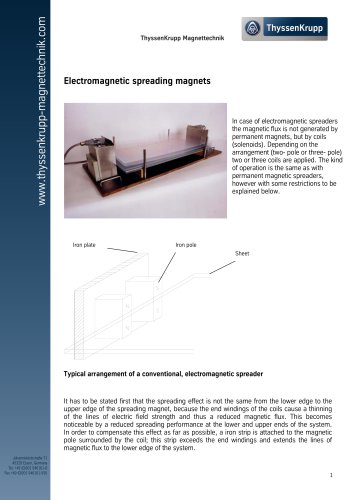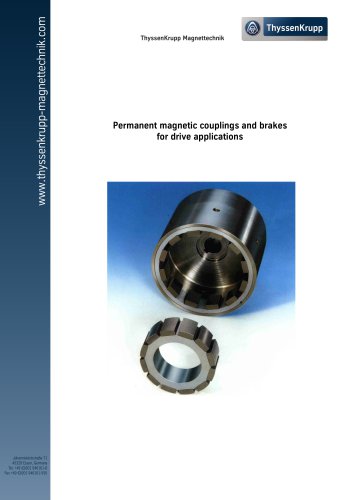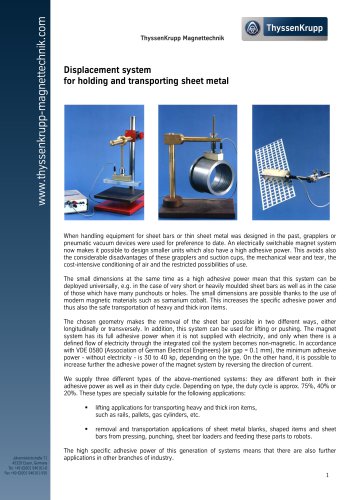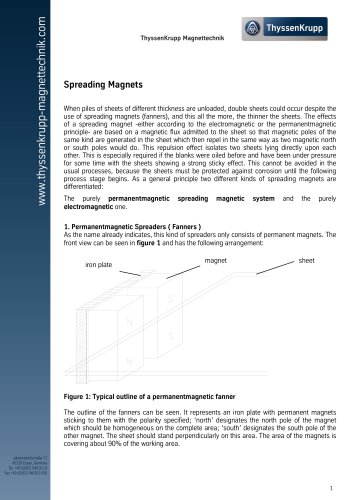Switchable magnet systems for stacking pieces of sheet metal0 pages
www.thyssenkrupp-magnettechnik.com
ThyssenKrupp Magnettechnik
Switchable magnet systems
for stacking pieces of sheet metal
These magnet systems, comprising permanent magnets and a coil, are used in particular for
transporting suspended ferromagnetic items of sheet metal. These systems can be used
especially cost-effectively wherever there is at least a 50% condition of „magnetically
adhering“. This ensures that the switch-on period of the coil is not greater than 50%. This
condition is always met for applications involving stacking systems. These systems are
optimized in respect of high levels of adhesive power, a mean deep action and a low
compensation current. These components effect an electrical time constant on the part of the
systems of approx. 50 ms to 120 ms. It is markedly less than in the case of pure
electromagnets. Given today’s usual stacking speed, it is necessary to provide the magnet
systems with control electronics which allow a switching frequency of up to 200 switches per
minute and more. Such a high switching frequency can, however, only be realized if the falling
sheet metal is subjected to an additional force so that the depositing process is accelerated
such as is the case with destacking systems.
1. The displacement system (monostable)
This system group is today used principally in stacking systems because it allows a high
switching frequency at the same time as a low compensation current; this suits the increasing
stacking speed.
Functional principle
Johanniskirchstraße 71
45329 Essen, Germany
Tel. +49 (0)201 946161-0
Fax +49 (0)201 946161-555
The principle of the design of these magnet systems is presented in Fig. 1. Two types are
distinguished. The Type 1 system shows the permanent magnet, the coil and the flux
conductance parts. The permanent magnet drives a magnetic flux through the iron items, with
the result that the ends of the field lines are able to leave the north pole which is generated and
enter the south poles. The pattern of the field lines is, in rough approximation, similar to that of
a semicircle. It is also approximately the case that the radius of the semicircle is a dimension
for the deep action of the system. Deep action should be understood in this context to refer to
the distance at which a 0.5 mm thick item of sheet metal just jumps with the whole area of the
magnet system being taken up. The permanent magnet is restricted on one side by a Usection, on the other, an iron plate forms the close. This iron plate has a double function.
Firstly, it collects the magnetic flux of the permanent magnet and conducts it via the centre
bridge to the north pole of the system; secondly, the iron plate forms the bypass for the flux
compensation in the event of the current flowing through the coil; the bypass is described in
greater detail below. If there is no current flowing through the coil, the adhesive power of the
magnet system is generated solely by the permanent magnet. In the case of the coil, it is now
possible to make current flow either in the supporting direction or in the compensating
direction. The supporting direction refers to the permanent magnet being supported by the coil
current and the adhesive power thus being still further increased. If the current flows in the
compensating direction (usual case), the adhesive power of the permanent magnet is
weakened. This weakening can be taken so far that almost none of the field lines leaves the
magnet system, resulting in the adhesive power disappearing. In this case, the iron plate on
the magnet has the function of conducting the magnetic flux of the coil in such a way that the
magnetic flux of the permanent magnet is exactly compensated. This logic implies that the
magnet system is magnetically neutral when a current is flowing, or, viewed the other way, that
the max. adhesive power occurs when no current is flowing. This corresponds to the normal
type of operation in sheet metal stacking. The exact opposite is the case as regards
electromagnets.
1

 عضویت
عضویت  ورود اعضا
ورود اعضا راهنمای خرید
راهنمای خرید





































